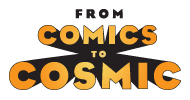“From Comics to Cosmic” is a new series from noted comic book writer/artist Steve Englehart. Read about the intense and often unbelievable ups and downs of his experience working in the comic industry. Check back daily for more of his exploits! Previous installments of “From Comics to Cosmic” can be found here.
Stan Lee is a living legend (he’s 87 at this writing, and you can see him hale and hearty doing a cameo in every Marvel Comics movie, as well as a recent Iron Man/Dr Pepper commercial). He was the nephew of the publisher and was made the editor in 1941, before the age of 19. That may have been nepotism, but he held that job until 1972 and guided the company to everything it is now. The job required everything an editor had to do in addition to the comic writing.
Over the years Stan has written in all the comics genres, from superheroes to westerns to romances to funny animals. By the 1960s, he may or may not have been burning out, but he was certainly losing interest. Then DC revived one of its World War 2 superheroes, The Flash, and Marvel’s publisher (still his uncle) asked Stan to create something to compete. He decided to toss out all the rules and make his hero, or heroes, more human. Thus was born the Fantastic Four, soon to be followed by all the other now-famous characters (especially Spider-Man), soon to be followed by Marvel’s domination of the industry. And with Stan still writing almost every book, he got up to thirteen titles a month before he finally, in the late 1960s, hired some assistants. Although that wasn’t necessarily to lighten his workload; it was to allow the company to continue its growth.
There is a story I heard when I went to work there, concerning the big blackout that struck New England in the mid-60s. The Marvel staffers stumbled down several stories of stairs to hunt up some cold food, and when they stumbled back up, they found Stan typing away in the light of a flashlight, having written half an issue of Thor. Clearly, the man loved what he was doing.
In 1972, he gave up writing to become Marvel’s publisher, but left the logo of “Stan Lee Presents” that began every story. He had been so identified with the comics that his departure was greatly feared, but he’d built such a strong brand and created such a strong “bullpen” that Marvel moved on without missing a beat. As it happened, I was part of that bullpen.
When I was merely a reader, the bullpen was part of Marvel’s great charm. Every month Stan Lee would include a “Bullpen Bulletins” in the comics, talking about the various artists (and later writers) who worked at the company—humanizing them. It presented the company as a small group of cool people having a great time producing the fantasy we readers enjoyed. In time, I got my chance to go to work at Marvel and discovered that Stan had been telling the absolute truth.
When I came on staff as a fill-in assistant editor, Marvel’s offices were just large enough—and no larger—to contain: two artists, a letterer, a colorist, a stat man, a receptionist, a secretary, a production manager, a couple of guys whose functions I don’t remember, me—and Stan. The first six people in the above list and I shared one space, the next four shared another, and Stan had his own office. That was it, all ensconced on the ninth floor of a space at Madison and 57th. This was indeed a small group of cool people having a great time producing fantasy. And as soon as I walked in the door, I was part of that group having a great time. It was certainly true that the Marvel Bullpen was not just marketing hype.
In fact, once I entered the comics world, I had three hundred instant friends. Since almost everyone who worked in comics lived in the New York area—as a prerequisite for getting the work—almost everyone I’d heard of was available for the same parties, the same volleyball games, and so on. Once you were in the club in any way, shape, or form, you were an equal to all of them (socially; certainly not professionally as yet). I stayed late at drunken parties with legendary artists and rode home on the subway at 4 am with people known to millions. I’m sure similar groupings exist all over New York, then and now, but I doubt that very many of them work like that, with the high and the low socially equal. In fact…

Steve Englehart is a novelist, comic book, film, television, and video game writer known for his work on high profile titles, including Marvel’s Captain America, The Hulk, The Avengers, Dr. Strange, DC’s Superman, Batman, Wonder Woman, Flash, Green Lantern, and many more.










